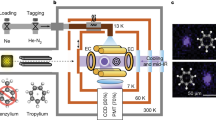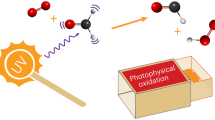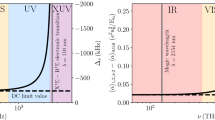Abstract
THE so-called ammonia band at 3360–70 A., photographed first by Eder in 1892, has since been studied and measured by many authors. Fowler and Gregory (Phil. Trans. Roy. Soc., 218, 351; 1919) have published beautiful photographs of it. Lately this band has been attributed by Barrat (Proc. Roy. Soc., A, 98, 40; 1920), Hulthen and Nakamura (NATURE, 119, 235; 1927), and others to the NH molecule. Using R. W. Wood's arrangement for the optical excitation of mercury vapour (Phil. Mag., Oct. 1925, Sept. 1927), I have observed the appearance of it when about 4 mm. nitrogen and very little hydrogen—perhaps a few thousands of mm.—are admitted to the quartz tube containing the mercury vapour which is being excited by the light of a water-cooled, magnetically deflected mercury arc.
This is a preview of subscription content, access via your institution
Access options
Subscribe to this journal
Receive 51 print issues and online access
$199.00 per year
only $3.90 per issue
Buy this article
- Purchase on Springer Link
- Instant access to full article PDF
Prices may be subject to local taxes which are calculated during checkout
Similar content being viewed by others
Author information
Authors and Affiliations
Rights and permissions
About this article
Cite this article
GAVIOLA, E. The NH Band and the Dissociation Energy of Nitrogen. Nature 122, 313–314 (1928). https://doi.org/10.1038/122313b0
Issue Date:
DOI: https://doi.org/10.1038/122313b0
Comments
By submitting a comment you agree to abide by our Terms and Community Guidelines. If you find something abusive or that does not comply with our terms or guidelines please flag it as inappropriate.



